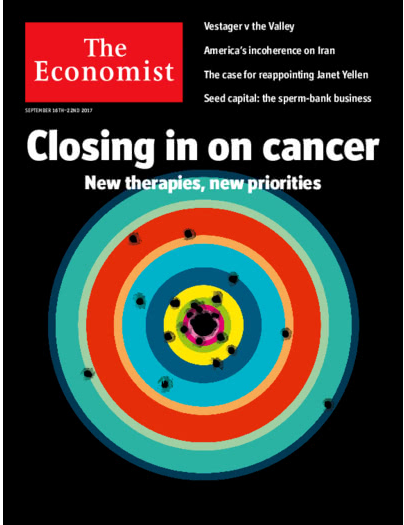Breath Biopsy® in The Economist’s Cancer Technology Quarterly
Published on: 15 Sep 2017
Our Breath Biopsy platform was mentioned in The Economist’s Cancer Technology Quarterly. Excerpts from the article are included below. For more details about our technology, download Breath Biopsy – The Complete Guide.
Understanding cancer’s unruly origins helps early diagnosis
And early diagnosis saves lives
Natasha Loder, Healthcare Correspondent, The Economist
For many cancers, early detection is “our greatest opportunity to improve survival,” says Mr Boyle. Mr Boyle wants to detect cancer on the breath using an ion-mobility spectrometer—a gadget that weighs chemicals by passing them through an oscillating electric field. The breath contains a wide range of organic molecules that reflect what is going on in the body’s metabolism. Cancers, which affect the metabolism, should in so doing change the pattern of molecules on the breath. Although Owlstone’s system is very small—it fits on a chip the size of a coin—it is sensitive, identifying molecules at a level of a few parts per billion. The firm hopes that when it has identified molecular “fingerprints” associated with particular cancers it will be able to detect the disease earlier than other tests do.
Later in the same article, liquid biopsy technology is discussed:
In liquid biopsies the challenge will be to detect cancer-specific signals against a noisy and confusing background. Barry Kramer, director of the division of cancer prevention at the NCI, warns that the same marker can have different functions in different organs. He notes that a programme screening infants for neuroblastoma was halted after it started to pick up too many growths that did not merit clinical concern and didn’t reduce the death rate. Specificity, says Mr Eltoukhy, is early detection’s Achilles’ heel. Others warn that liquid biopsies aimed at DNA will never be sensitive enough for early detection, because early tumours may shed very little DNA, or shed it only occasionally; other molecules might prove more telling.
The costs and difficulties of blood screening are one of the things that tiny Owlstone has going for it. Testing the breath for metabolites doesn’t require the tumours to have started shedding DNA. Britain’s NHS is running a £1.1m trial of the technology in patients suspected of having lung cancer who are also being examined by other means. If this finds the technology to be reliable it might be expanded for use in population screening. In July Owlstone said it would collaborate with academic partners to see if breath biopsies could be expanded to pick up bladder, breast, kidney, pancreatic, prostate, brain, and head and neck cancers.
There is no question that blood biopsies will be at the heart of the future of tracking and profiling tumours. But for early detection other options might yet win out; success will not hinge on which company starts with the most money but which offers the biggest bang for the buck. Health-care systems will seek to adopt technologies that work at scale. The benefit will be that more cancers can be cured with the most basic, oldest and most effective methods of cancer treatment.
Media contact
For more information please contact:
Sarah Jeffery, Zyme Communications
sarah.jeffery@zymecommunications.com
+44 (0)7771 730 919
